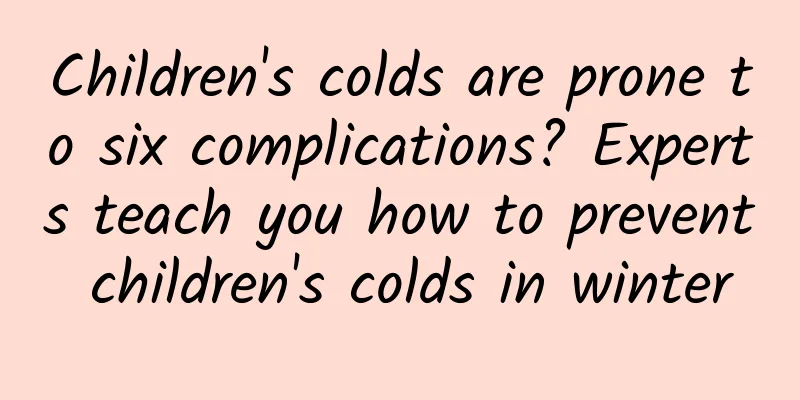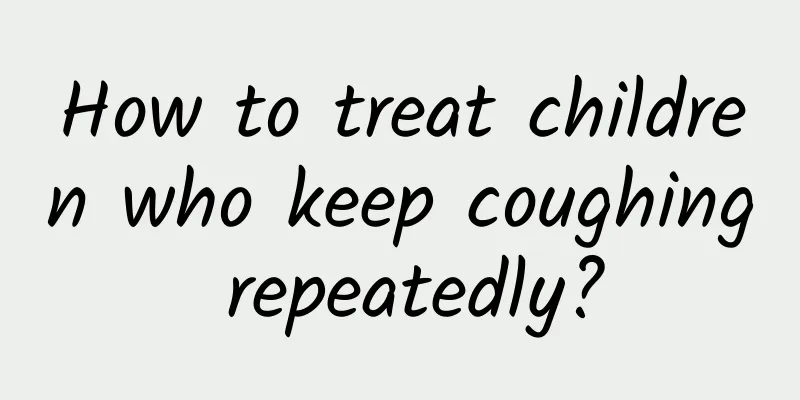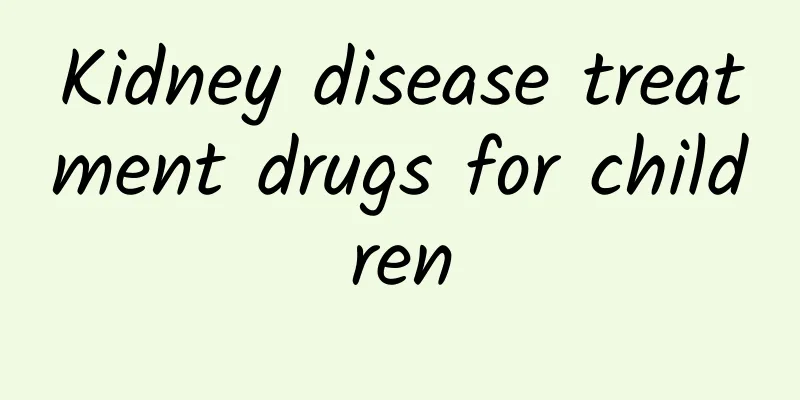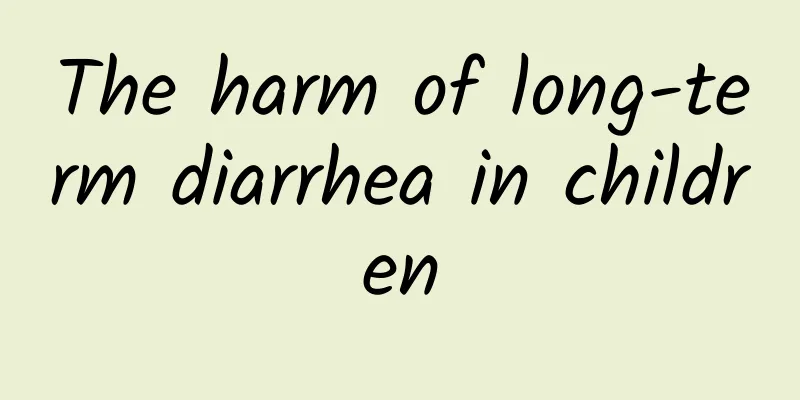Children's colds are prone to six complications? Experts teach you how to prevent children's colds in winter

|
Children's cold is a common disease, especially in the cold winter. We must be aware of its harmfulness to children, and also pay attention to reasonable preventive measures to reduce the occurrence of the disease. Complications of colds in children 1. Laryngitis: The larynx is adjacent to the pharynx and is the narrowest part of the upper respiratory tract. Once inflammation occurs, the entire respiratory tract cavity can easily become narrower, which can cause airway obstruction. Children aged 2 to 3 are prone to this disease. Those who come to the clinic are all in emergency. The children experience difficulty breathing, shortness of breath, hoarseness, loss of voice, irritability, sweating on the head, and cold limbs. In severe cases, airway obstruction causes tissue hypoxia, resulting in damage to the brain, heart, and kidneys. 2. Tonsillitis: Tonsillitis is a common disease in children, and most of them also have pharyngitis. The tonsils in infants are not yet developed. They reach their peak development from 4 to 12 years old, and are located on the back sides of the mouth. There are many crypts on the surface of the tonsils. Once infected, the child will complain of sore throat, swallowing water, swallowing pain, sometimes involving pain at the base of the ear, dry cough, fever, chills in severe cases. Since the tonsils are the largest glands in the human body, they have a defensive function for the human body. If they are not often inflamed, surgical removal is not recommended. When they are inflamed, they can be cured with anti-inflammatory drugs. 3. Rhinitis: The nasal mucosa of a normal baby is rich in blood vessels and is particularly soft and delicate. The nasal cavity is the first barrier for air to enter the lungs. When stimulated by the cold winter air and invaded by external bacteria and viruses, the nasal mucosa can become inflamed. The damaged nasal mucosa becomes edematous and thickened, making the already narrow nasal cavity appear even narrower. Difficulty breathing, nasal congestion, poor ventilation, mouth breathing, dry throat, easy coughing, and sometimes low fever may occur, while others may not. These are manifestations of rhinitis. 4. Eustachian tube inflammation: There is a channel between the pharynx and the ear, called the Eustachian tube. The Eustachian tube of infants and young children is horizontal, with the two ends of the tube located in the pharynx and the ear respectively. Therefore, when the pharynx is inflamed, it is easy for the inflammation to go along the tube to the ear. When suffering from pharyngitis, the child will complain of ear pain. Using an otoscope, it can be seen that the ear canal is red, with secretions, and even pus and fever. This is an ear disease caused by pharyngitis, and you should go to the ear department for treatment in time. 5. Nasolacrimal duct inflammation: It is more common in infants under 1 year old. This duct is a passage between the inner canthus of the eye and the nasal cavity. When rhinitis occurs, the inflammation can easily spread to the root of the nose and even to the eyes. The conjunctiva of both eyes becomes red, congested, tearful, and runny. There is secretion in the eyes. The skin between the eyes and the nose becomes red and slightly swollen. This area is particularly rich in blood vessels and the tissue is particularly soft. The inflammation can continue to spread to the brain and should be taken seriously by parents. Causes of colds in children 1. Infection by pathogens: Most upper respiratory tract infections in infants are caused by viruses. The nasal cavity of babies under one year old is very narrow and they have few nasal hairs. In addition, the nasal mucosa of babies is very tender, which leads to insufficient secretion of their mucosal glands and inability to resist viral infection. 2. The baby's immune function is not well developed: Relevant research has pointed out that babies under 1 year old have the least immunoglobulin IgM and the worst ability to resist infection. By the age of 3, it can reach the adult level, which is one of the reasons why children's colds gradually decrease in school-age children. 3. The indoor environment is relatively poor: When the indoor environment is dark and damp, the air circulation is poor, or the indoor temperature is too high or too low, it will cause great harm to the baby's respiratory tract. In this case, it is very easy to induce a cold in children. 4. Hot and cold environment: Hot and cold weather always catches mothers off guard. The temperature difference is too big. If mothers don't have time to add or remove clothes for their babies, the babies will be stimulated by the cold air and it is very easy to catch a cold. 5. Related to the baby's diet: A survey shows that if the baby grows too fast, the mother's breast milk is insufficient, and the baby drinks milk powder, or the baby does not eat a balanced and nutritious diet due to reasons such as picky eating and anorexia, it will easily lead to varying degrees of lack of trace elements, thereby greatly increasing the chances of catching a cold. Prevention of colds in children 1. Ensure that your baby sleeps for about 12 hours a day. Babies can slowly recover their physical strength and energy during sleep. If the baby's sleep quality is poor or the sleep time is short, the baby's resistance will be relatively weak. If the baby is blown by cold wind at this time, the chance of catching a cold will be relatively increased. 2. Strengthen your baby's outdoor exercise, which can enhance your baby's ability to resist colds. Children's colds mostly occur in winter and spring. In these two seasons, mothers should strengthen their baby's outdoor exercise. Don't stop taking your baby to exercise outdoors just because it's cold. 3. The baby's clothes and quilts should be added or removed in time according to the temperature changes. When the weather is cold, mothers should add clothes to the baby; when the weather is warm, they should also reduce the baby's clothes and not wear too many clothes. So how can we judge whether the baby's clothes are suitable? In fact, it is very simple. Just touch the baby's feet and hands. As long as the hands and feet are warm, it means that the clothes the baby is wearing are suitable. 4. Feed your baby more foods rich in vitamins and a balanced diet. Vitamin A and vitamin C can enhance the baby's immunity and resist viruses. In normal times, mothers may wish to feed their babies more milk, strawberries, eggs, carrots and other foods, which are rich in vitamins and can make the baby's body stronger. |
<<: Why do babies have jaundice? Detailed analysis of the 4 reasons why babies may have jaundice
Recommend
Is 13.5 jaundice on 14 days considered high?
Jaundice is more common in the neonatal period. J...
Nursing children with pneumonia should not be blind
Among lung diseases, pneumonia can be said to be ...
Why do children have diarrhea?
Diarrhea diseases are quite common in life. Many ...
The characteristic signs of patent ductus arteriosus in children are
Patent ductus arteriosus (PDA) in children is usu...
What are some simple ways to prevent mumps?
As people's pace of life accelerates, many pe...
What are the symptoms of baby eczema? Where does baby eczema usually appear?
Baby eczema tends to occur on forehead eyebrows, ...
Can polio be cured now?
Polio is a relatively serious disease that affect...
How to take cod liver oil better? The correct way to use cod liver oil
Cod liver oil is a commonly used medicine for chi...
Will eczema recur in children?
Many mothers will encounter this situation: the b...
What are the common symptoms of phenylketonuria?
The "killer" of baby intelligence - neo...
What to do if a child has a stuffy nose and cough? What are the causes of a stuffy nose and cough in a child?
Children with nasal congestion and cough are very...
Comparison table of jaundice values for newborns at 10 days old
Newborn babies have imperfect body functions and ...
What tests are done to confirm Hirschsprung's disease?
Examination of Hirschsprung disease usually requi...
Effective treatment for jaundice in babies
What is the effective treatment for reducing baby...
What are the causes of diarrhea in children?
The causes of pediatric diarrhea may include infe...









